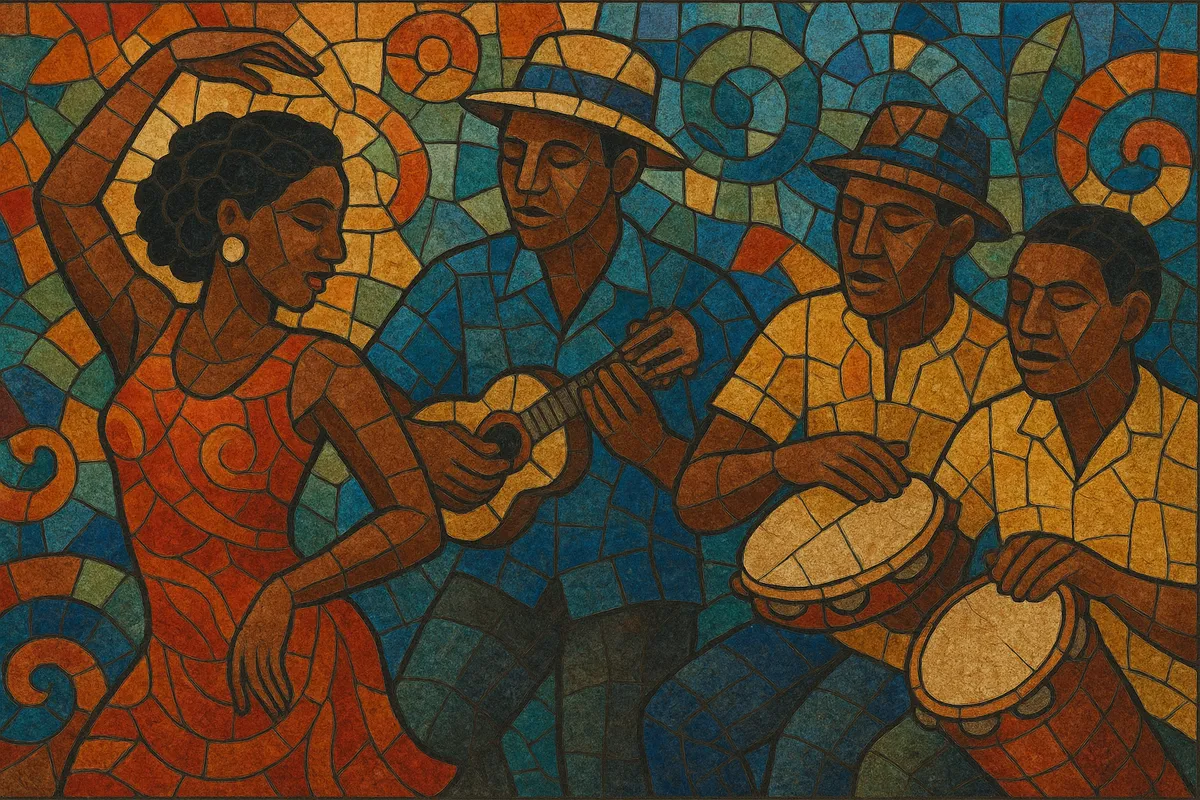Samba is an Afro‑Brazilian musical and dance tradition that crystallized in Rio de Janeiro in the early 20th century, rooted in the rhythms, rituals, and communal celebrations of the Afro‑diasporic population.
It is typically in 2/4 meter with characteristic syncopations, off‑beat accents, and call‑and‑response refrains. The groove is carried by a bateria (percussion ensemble) featuring surdo, pandeiro, tamborim, cuíca, agogô, reco‑reco, and repinique, while chordal instruments such as violão (6‑ and 7‑string guitars) and cavaquinho provide rich, swinging harmonies. Melodies often draw on Portuguese lyric traditions, African rhythmic phrasing, and the expressive poetics of everyday urban life—love, neighborhood pride, carnival, devotion, and saudade.
Across the 20th century, samba diversified into many substyles (samba‑canção, samba‑enredo, partido‑alto, samba de roda, samba de gafieira), and later catalyzed entire currents like bossa nova, MPB, and samba‑rock, remaining Brazil’s most globally recognizable sound.
Samba’s roots lie in Afro‑Brazilian communities (especially Bahian migrants) who settled in Rio de Janeiro. They brought circle dances and drumming practices (batuque) and religious music tied to candomblé, blending with urban salon song (modinha), choro ensembles, and European social dances such as polka and the maxixe. By the 1910s, gatherings in casas das tias (matriarchal households) fostered a distinct carioca samba. The 1917 recording of “Pelo Telefone” (often credited to Donga, with collective authorship) became a landmark.
Carnival and the burgeoning radio‑film industry propelled samba nationwide. Noel Rosa, Ismael Silva, Cartola, Ary Barroso, and Pixinguinha refined songwriting, harmony, and orchestration; samba‑canção emphasized lyrical, slower forms, while samba‑enredo linked schools (escolas de samba) to elaborate Carnival parades. Arrangements grew more sophisticated, with brass, strings, and studio orchestras supporting star singers (Carmen Miranda, among others) as samba became Brazil’s emblem abroad.
Partido‑alto and gafieira kept dance‑floor traditions vibrant, while composers like Paulinho da Viola upheld classic forms. In the late 1950s, bossa nova recast samba’s rhythm on the guitar with jazz harmonies, influencing MPB and international pop. The 1960s–70s also saw sambalanço and samba‑jazz fuse bebop phrasing with samba grooves, and samba‑soul reflect Afro‑American funk and soul currents.
Pagode (as a modern, commercially successful revival) foregrounded the cavaquinho, tantan, and banjo‑cavaquinho, with catchy refrains and neighborhood storytelling. Artists such as Beth Carvalho (a crucial bridge figure), Zeca Pagodinho, and Martinho da Vila sustained mass appeal while honoring roots. Samba‑reggae in Bahia infused Afro‑Bahian blocos with polyrhythms and reggae backbeats, projecting a new carnival energy.
Samba remains central to Brazil’s identity, thriving in rodas (jam circles), community schools, and global festivals. It cross‑pollinates with jazz, electronic music, and hip‑hop, while traditional substyles (samba de roda, partido‑alto, samba‑enredo) continue to anchor heritage, pedagogy, and local pride. Today, samba is both a living folk practice and a sophisticated art form shaping—and shaped by—Brazil’s cultural modernity.


